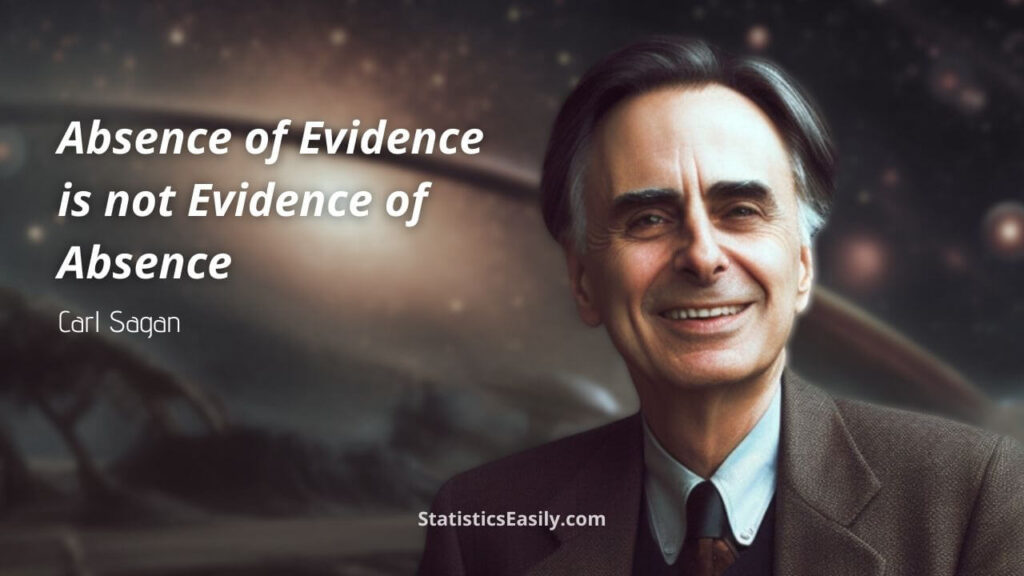Absence of Evidence is not Evidence of Absence
Explore the depth of ‘Absence of Evidence is not Evidence of Absence’ in data analysis and its critical role in scientific and everyday judgments.
Introduction
In the contemplative words of Carl Sagan, “Absence of Evidence is not Evidence of Absence” serves as a foundational pillar in statistical analysis and scientific inquiry. While seemingly simple, this maxim encapsulates a profound truth pivotal to understanding the intricacies of data interpretation and decision-making processes. The essence of this statement challenges the conventional notion that the lack of evidence to support a hypothesis equates to proof of its falsity. It beckons a deeper dive into the nuanced landscape of evidence-based reasoning, urging researchers and analysts alike to adopt a more comprehensive approach in their investigative endeavors.
The significance of this concept extends beyond the confines of academic discourse, permeating the fabric of everyday judgment and critical thinking. In data analysis, where evidence serves as the bedrock of informed decision-making, acknowledging the distinction between the absence of evidence and the evidence of absence is crucial. It safeguards against the premature dismissal of hypotheses. It fosters a thorough investigation and skepticism culture, vital for advancing scientific knowledge and promoting a more enlightened society.
In the ensuing sections, we shall explore the multifaceted implications of this principle, employing a dataset that exemplifies the potential pitfalls of neglecting this tenet in statistical analysis. Through a blend of theoretical discourse and practical application, this article aims to illuminate the critical role that evidence, or the lack thereof, plays in shaping our understanding of the world around us.

Highlights
- Misinterpreting the absence of evidence can lead to false negatives in hypothesis testing.
- Overlooking this principle may result in biased data interpretation and conclusions.
- Recognizing evidence absence is crucial in avoiding premature decisions in research.
- This concept underlines the importance of thorough investigation in scientific inquiry.
- It highlights the need for critical thinking in everyday decision-making processes.
Ad Title
Ad description. Lorem ipsum dolor sit amet, consectetur adipiscing elit.
The Principle Explained
“Absence of Evidence is not Evidence of Absence” – a statement that resonates deeply within statistical reasoning and scientific inquiry. This principle is a crucial reminder that the lack of evidence supporting a hypothesis does not necessarily invalidate it. In data analysis, this tenet underscores the importance of a comprehensive approach to evidence evaluation, emphasizing that the absence of findings should not be mistaken for proof of non-existence.
The concept encourages a cautious interpretation of data, advocating for considering all possible outcomes, including those not immediately apparent. It highlights the inherent limitations of empirical research, where the unavailability of evidence might be due to the inadequacies of the current investigative methods or the constraints of the existing dataset, such as the one previously created.
For instance, an experiment marked as “Inconclusive” due to the absence of evidence does not necessarily imply the non-existence of the phenomenon under investigation. It rather signifies the need for further research, possibly with enhanced methodologies or expanded data collection, to draw definitive conclusions.
This principle is paramount in avoiding the pitfalls of confirmation bias, where researchers might prematurely reject hypotheses due to the lack of supporting evidence, potentially overlooking critical insights. It advocates for a more nuanced and open-ended approach to scientific investigation, encouraging researchers to remain receptive to multiple hypotheses and outcomes.
In statistical analysis, this principle is particularly relevant in hypothesis testing, where the failure to reject a null hypothesis is not the same as accepting it. It indicates insufficient support to conclude otherwise based on the available evidence. This distinction is crucial for accurate data interpretation and sound decision-making, ensuring that conclusions are drawn based on a comprehensive evaluation of all available evidence, including its absence.
Application in Statistical Analysis
In statistical analysis, the principle “Absence of Evidence is not Evidence of Absence” is critical, particularly in hypothesis testing, data interpretation, and decision-making processes. This concept underscores the importance of carefully and thoroughly evaluating data — or the lack thereof — before concluding.
Hypothesis Testing: In hypothesis testing, this principle reminds us that the inability to find evidence supporting an alternative hypothesis does not automatically validate the null hypothesis. Instead, it can suggest a lack of statistical power or the need for a more refined research methodology. For instance, considering our dataset, an experiment yielding no significant evidence does not necessarily negate the presence of an effect; it may merely indicate the need for a larger sample size or a different experimental design.
Data Interpretation: When interpreting data, it’s crucial to recognize that the absence of evidence can be misleading if taken as conclusive proof of non-existence. This awareness is particularly vital in fields where data is sparse or difficult to obtain. Analysts must remain open to the possibility that future evidence may emerge with improved data collection techniques or technologies, fundamentally altering current interpretations.
Decision-Making: This principle advocates caution and skepticism, especially without clear evidence. Decisions should be based on a comprehensive assessment of all available information, including acknowledging when evidence is insufficient. This approach prevents premature conclusions leading to erroneous policies, strategies, or scientific assertions.
Incorporating this principle into statistical analysis ensures a more nuanced and robust approach to research and decision-making. It fosters an environment where hypotheses are not dismissed lightly, data is interpreted with a keen awareness of its limitations, and decisions are made with a full appreciation of the existing evidence and its absence.
Case Studies
This section examines real-world scenarios where misinterpreting the “Absence of Evidence is not Evidence of Absence” led to incorrect conclusions. These case studies underscore the importance of this principle in statistical analysis, scientific inquiry, and decision-making processes.
Case Study 1: Medical Diagnosis and Rare Diseases
In the medical field, the absence of common symptoms or markers for a disease has sometimes led to the incorrect conclusion that a patient is free from that disease. For instance, rare diseases often present atypical symptoms that can be overlooked or misinterpreted. A notable example involves some cases of Lyme disease, where the absence of the characteristic “bulls-eye” rash led to a delayed diagnosis, worsening the patient’s conditions. This case highlights the critical need for healthcare professionals to consider the absence of evidence (the rash), not as evidence of absence (the disease), urging a more thorough investigation and consideration of alternative diagnostic tests.
Case Study 2: Environmental Science and Endangered Species
In environmental science, the principle has significant implications for the conservation of endangered species. For example, the ivory-billed woodpecker was long thought to be extinct because of the absence of confirmed sightings. However, sporadic evidence suggesting its existence led to reevaluating its status and conservation efforts. This case illustrates the danger of concluding the extinction of a species based solely on the absence of sightings, emphasizing the need for comprehensive habitat studies and conservation strategies that account for the possibility of undetected populations.
Case Study 3: Astronomy and Exoplanet Discovery
In astronomy, the early days of exoplanet discovery were marked by a lack of evidence for planets outside our solar system, leading some to question their existence. However, developing more sensitive detection methods revealed thousands of exoplanets, radically changing our understanding of the universe. This evolution in astronomy is a powerful reminder of the principle’s relevance: the initial absence of evidence for exoplanets was not evidence of their absence, underscoring the importance of technological advancement and persistence in scientific inquiry.
Case Study 4: Forensic Science and Wrongful Convictions
Forensic science has witnessed instances where the absence of conclusive evidence against a suspect led to wrongful convictions. One such case involved the misinterpretation of DNA evidence, where the lack of a match was used to exclude suspects from investigation, later found to be erroneous. This case stresses the necessity of a cautious approach in legal and forensic contexts, where the stakes of misinterpreting the absence of evidence are exceptionally high, impacting lives and justice.
Case Study 5: Archaeology and Historical Civilizations
In archaeology, the discovery of the Mayan civilization’s advanced cities in the dense jungles of Central America challenged previous assumptions about the region’s historical habitation. Before these findings, the lack of visible structures led many to underestimate the complexity and extent of Mayan civilization. This case study reinforces the principle by demonstrating how the absence of evidence due to overgrowth and decay over centuries was mistakenly taken as evidence of the absence of an advanced civilization.
These case studies from diverse fields illustrate the widespread relevance of the principle that “Absence of Evidence is not Evidence of Absence.” They underscore the importance of maintaining a critical and open-minded approach in the face of absent evidence, advocating for further investigation, and considering all possible outcomes before concluding.
Implications in Science and Everyday Life
The axiom “Absence of Evidence is not Evidence of Absence” profoundly impacts scientific exploration and the nuances of daily decision-making. It champions diligent and critical information evaluation, advocating for a culture that values in-depth inquiry and reasoned skepticism across all spheres of life.
This principle is a cornerstone within the scientific community. It emphasizes an open stance towards hypotheses and potential breakthroughs, even amid current evidentiary gaps. Such an attitude is vital for pushing the boundaries of knowledge forward, encouraging relentless pursuit and refinement in research methodologies. This ethos may pave the way for revolutionary findings that defy and expand upon the established scientific understanding.
The relevance of this principle in the broader scope of everyday life cannot be overstated. It serves as a prudent reminder to withhold swift judgments in situations marked by uncertainty or incomplete data. This cautious approach is particularly critical in today’s digital era, characterized by an overwhelming flood of information and, occasionally, misinformation. A discerning evaluation of the available evidence and an awareness of its limitations is crucial for making well-informed choices.
Moreover, this principle holds significant weight in legal proceedings and policy formulation. It reinforces the foundational concept of justice that individuals are presumed innocent without concrete evidence to the contrary, advocating for comprehensive investigations before reaching legal conclusions. Policy-making urges leaders to contemplate a broad spectrum of evidence and potentialities, including those not immediately apparent, before enacting measures that impact the community.
Adopting the “Absence of Evidence is not Evidence of Absence” philosophy encourages a more reflective, inclusive, and investigative society. This mindset nurtures a deeper comprehension of the complexities of our world, fosters equitable and empathetic interactions among individuals, and contributes to a more enlightened and nuanced public dialogue.
While the principle “Absence of Evidence is not Evidence of Absence” significantly enriches scientific inquiry and daily discernment, it also serves as a gentle reminder of the limitations inherent within a strictly empirical approach to understanding our world. It’s essential to recognize that the quest for truth transcends the boundaries of science, embracing the profound insights offered by philosophy, history, music, art, and religion, among other disciplines. These realms explore dimensions of human experience and reality that often lie beyond the empirical and measurable, addressing questions of meaning, purpose, and value that science alone may not fully encompass. This acknowledgment invites a harmonious dialogue between various forms of knowledge, cautioning against the pitfalls of extremism and scientism, where science is inadvertently elevated to a dogma.
Ad Title
Ad description. Lorem ipsum dolor sit amet, consectetur adipiscing elit.
Conclusion
In conclusion, the principle “Absence of Evidence is not Evidence of Absence” serves as a vital beacon in the pursuit of knowledge, guiding us through the complexities of scientific exploration and the intricacies of everyday decision-making. This article has traversed the landscape of this maxim, underscoring its pivotal role in fostering a culture of rigorous investigation, critical thinking, and open-mindedness across various domains.
We’ve seen how this principle acts as a bulwark against the hasty dismissal of hypotheses in scientific research, advocating for a more profound and expansive approach to inquiry that embraces the potential for groundbreaking discoveries. Similarly, in our daily lives, it encourages us to navigate the deluge of information with discernment and caution, reminding us of the value of withholding judgment in the face of incomplete evidence.
Moreover, this discourse has highlighted the principle’s broader societal implications, from the legal realm’s emphasis on thorough investigation and the presumption of innocence to policy-making’s need for careful consideration of evidence and possibilities. By embracing this principle, we cultivate a society that values justice, empathy, and informed decision-making.
It’s crucial to acknowledge that the search for truth is multifaceted, extending beyond the empirical realm to include the rich insights of philosophy, art, religion, and more. This holistic approach to understanding emphasizes that specific questions, especially those of a metaphysical nature, may elude scientific validation or refutation, inviting a respectful coexistence of diverse knowledge systems.
Recommended Articles
Delve deeper into the intricacies of data analysis and evidence interpretation by exploring more articles on our blog. Enhance your understanding and decision-making skills with our expert insights.
- 10 Revolutionary Techniques to Master Statistics and Data Analysis Effortlessly!
- Those Who Ignore Statistics Are Condemned to Reinvent it
- How Statistics Can Change Your Life: A Guide for Beginners
- 7 Myths About Statistics You Need to Stop Believing
- 5 Statistics Case Studies That Will Blow Your Mind
- Quotes on Statistics and Data Analysis
- Statistics is the Grammar of Science
Frequently Asked Questions (FAQs)
Q1: What exactly does “Absence of Evidence is not Evidence of Absence” signify? It underscores the critical understanding that the lack of evidence to support a claim does not inherently prove the opposite true, emphasizing a more nuanced approach to evidence evaluation.
Q2: In what way is this principle relevant to hypothesis testing in statistical analysis? This principle cautions against prematurely accepting the null hypothesis due to a lack of evidence for an alternative hypothesis, highlighting the need for comprehensive analysis and consideration of all possible outcomes.
Q3: How might overlooking the absence of evidence lead to erroneous conclusions in scientific research? Neglecting this principle can result in false negatives or the incorrect rejection of valid hypotheses, underscoring the importance of thorough investigation and skepticism in scientific inquiry.
Q4: Can you explain the impact of this principle on data interpretation and decision-making? It emphasizes the importance of critically assessing data or the lack thereof. It encourages decision-making based on a holistic view of all available information, fostering informed and balanced conclusions.
Q5: What does a ‘false negative’ mean in the context of this principle? A false negative refers to a situation where a test or analysis fails to detect a present condition or effect, often due to the incorrect interpretation of an absence of evidence.
Q6: How can one prevent the misinterpretation of the absence of evidence? By adopting a critical mindset that values multiple hypotheses and outcomes and by recognizing the limitations of current methodologies or data sets in providing conclusive evidence.
Q7: What significance does this principle hold outside scientific contexts, such as everyday life? It teaches the value of withholding judgment and maintaining a skeptical and investigative stance when faced with incomplete information, enhancing daily life’s critical thinking and decision-making skills.
Q8: How does this principle help in mitigating research biases? Encouraging the consideration of all relevant evidence and maintaining openness to various outcomes helps prevent confirmation bias and promotes a more objective and inclusive approach to research.
Q9: What broader implications does this principle have for advancing knowledge and understanding? It fosters a comprehensive and open-minded approach to exploration and inquiry, which is crucial for uncovering new insights and challenging existing paradigms across disciplines.
Q10: What are effective ways to teach the importance of this principle? Incorporating real-world case studies and examples highlighting the consequences of overlooking the absence of evidence can illuminate its significance and application in various contexts.








